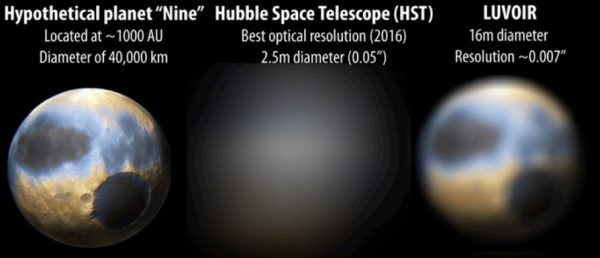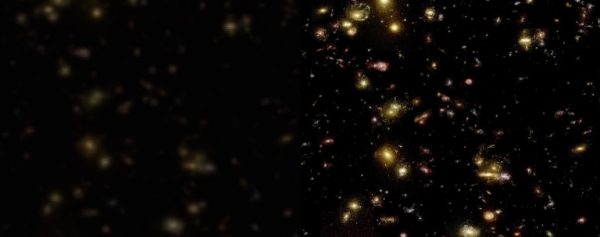"Hubble often takes images of distant gravitationally lensed galaxies to infer their substructure and to try to learn about early galaxies in general. For LUVOIR, we would have that same resolution for any galaxy! That’s truly revolutionary." -John O'Meara
If you were an observational astronomer, what would your dream telescope look like? It would have to be huge, with an incredible amount of light-gathering power. The quality of the optics would have to be pristine, and higher-precision than anything ever created before. It would have to have multispectral capabilities, extending beyond both sides of the visible light spectrum. And it would have to be in space, with no interference from our atmosphere. If we could build a telescope like that, so many things would immediately become possible.
 Is 'Planet Nine' real? If so, most ground-based telescopes or even current/future space-based telescopes will be barely able to image a single pixel's worth of it. But LUVOIR will be able, even at its great distance, to reveal intricate structure on the surface of the world. Image credit: NASA / LUVOIR concept team.
Is 'Planet Nine' real? If so, most ground-based telescopes or even current/future space-based telescopes will be barely able to image a single pixel's worth of it. But LUVOIR will be able, even at its great distance, to reveal intricate structure on the surface of the world. Image credit: NASA / LUVOIR concept team.
We’d be able to directly image perhaps 100 exo-Earths around nearby stars, including spectra of their atmospheres. We’d take images of Jupiter of the same quality that JUNO can, but from Earth’s orbit. We’d be able to measure the star clusters inside and gas halos surrounding every galaxy in the Universe to just a few hundred light year-precision. And we’d be able to take high-resolution images of the faintest, most distant galaxies of all, in just a tiny fraction of the time it’s taken Hubble to do it.
 A simulated view of the same part of the sky, with the same observing time, with both Hubble (L) and LUVOIR (R). The difference is breathtaking. Image credit: G. Snyder, STScI /M. Postman, STScI.
A simulated view of the same part of the sky, with the same observing time, with both Hubble (L) and LUVOIR (R). The difference is breathtaking. Image credit: G. Snyder, STScI /M. Postman, STScI.
There’s a 15.1-meter space telescope that’s in design right now: LUVOIR. If everything goes well, it could be NASA’s flagship mission of the 2030s.
- Log in to post comments





I suppose these things take a long time to get off the ground, but we haven't even hoisted the James Webb Telescope yet.
Is the whole site frozen or is it just my computer?
@Ethan wrote:
Minor quibble here. Even at the most aggressive build schedule for LUVOIR, the heaviest-design launch vehicle will be the SpaceX ITS at a lifting capability of 550,000 kg as compared to SLS's 130,000 kg. Even the Chinese should have Long March 9 able to lift 140,000 kg by then.
I'm all for going forward with this telescope and I typically hate NASA's flagship missions for their cost overruns and development delays. I think that James Webb is a stupid design with a ridiculously short operational life for how much it costs. I liked Hubble because it was serviceable and I like LUVOIR for the same reason. Lets get it going and fire anyone who so much as mentions spending NASA money on a manned mission to Mars, and anyone at NASA who wants to siphon money off for the StarShade should be sent to Guantanamo.
Denier,
LOL! Don't hold it in - tell us how you really feel!